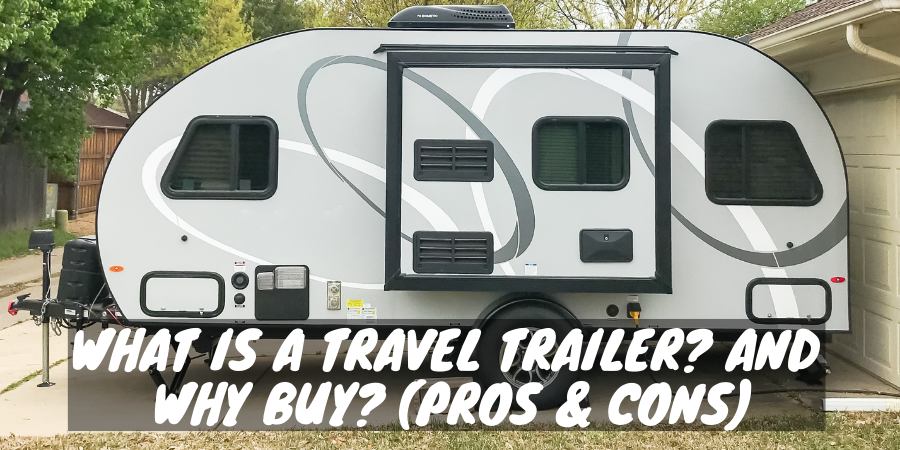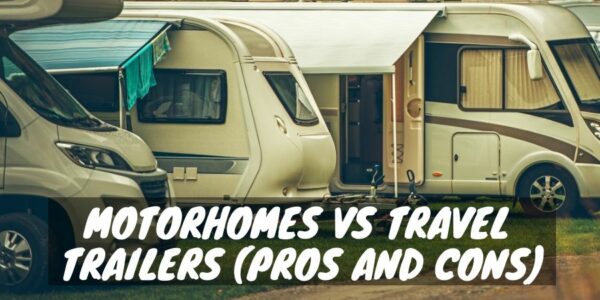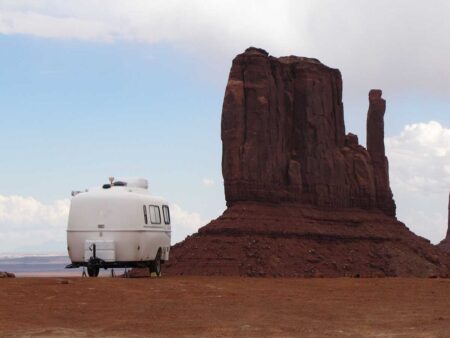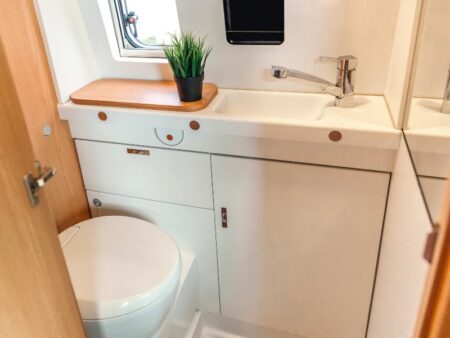According to the Recreational Vehicle Industry Association (RVIA), 46 million Americans planned to take an RV vacation in 2020. Those that achieved that plan used a travel trailer, the most popular RV category.
If you’re looking to fulfill your travel trailer plan, we’ll show you everything you want and need to know about the most versatile RV category. You’ll learn what to expect, the many subcategories, and some of the best towing vehicles that match well.
Key Points
- Travel trailers are the most versatile category of RV
- The lightest travel trailers can be pulled by 4-cylinder cars
- There are over 200 travel trailer brands worldwide, and 90% are made in the U.S.
- Almost any budget can afford a travel trailer
- The most basic kitchenettes have enough cooking devices to create full meals
What is a Travel Trailer

FEMA defines a travel trailer as a single chassis vehicle that measures less than 400 square feet. Its primary purpose is to provide temporary living quarters for recreational, camping, travel, or seasonal use.
Federal and State Department of Transportation Laws state that the vehicle must have certain features like sleeping areas, kitchens, installed electricity, and other requirements. Each state has its intricacies, but there are minimum standards the trailer must meet for registration and titling purposes.
For all intent and purposes, a travel trailer is a hard-shelled trailer your hitch up to your vehicle with specific features that allow you and your family to sustain yourself on outdoor vacations.
This category of RV is the most versatile in the RV world. If you were to pull a 13-foot travel trailer next to a 45-foot model, they might have features that correlate, but it’d feel like you’re comparing a Ford Fiesta to a Hummer Limousine.
History of Travel Trailers
RVs’ motorized version can trace its origins to 1910 when people started taking Henry Ford’s affordable car’s ideas and creating the first towables or the 1915 Conklin’s “Gypsy Van” Motorhome.
The Romani Culture and Irish Travelers were the ones to master the towable home concept. These two cultures mastered the art of the nomadic lifestyle centuries before. In the United States, our western expansion in the 1800s with covered wagons planted the seed in our own culture.
The modern-day travel trailer owes much of its design to Arthur Sherman’s Covered Wagon. After a disastrous camping adventure in northern Michigan (the north part of the lower peninsula for non-Michiganders), he invested $500 to create a hard-shelled travel trailer prototype to display at the 1930 Detroit Auto Show.
The response was so great; he ended up making over $3 million in his first year (remember this is 1930, two years after the great depression started). With help from his first employee, a carpenter, this scientist-turned-entrepreneur stayed in business through World War II as a contractor for the war effort.
Unfortunately, after the war, instead of getting back into the RV business, the board moved on to other things, selling the company. Today’s travel trailers still trace their engineering history to the breakthroughs Sherman made with his Covered Wagon. You can see a 17-foot 1935 Covered Wagon on display at the RV Hall of Fame in Elkhart, Indiana.
Ultra-Lite Travel Trailers (Under 3,000 Pounds, Below 23 Feet)
When the American public had to face the reality that the average price of gas wasn’t going below $2 a gallon, it changed how we make our choices. We bought more fuel-efficient cars, lived closer to our jobs, and became smarter with our money.
The RV industry had to adapt to this change. Before this new era, travel trailers under 3,000 pounds were usually stripped-down units that appealed to those looking for the “roughing it” experience.
With new technologies, the ultra-lite small travel trailer category turned base-models that sat in the back corner of the lot into the blinged-out, center stage best sellers RV dealers have a hard time keeping in stock. Most small SUVs and quarter-ton pickup trucks won’t have a problem pulling these gems to your favorite campsite.
Travel trailers in this category are great for couples. You’ll also find bunkhouse travel trailers for families of four. The features and amenities are comfortable due to the space-saving technologies seen within them. Travel trailers with murphy beds open up space with their daytime sofa.
Kitchens will have stoves and ovens that maybe half the size of a residential version, but their gas burners will cook healthy and delicious meals. Ultra-lites come with holding tanks and are 30 amp, so dry camping with alternative electric sources isn’t a problem.
Lightweight/Lite Travel Trailers (Under 5,000 Pounds, Below 25 Feet)
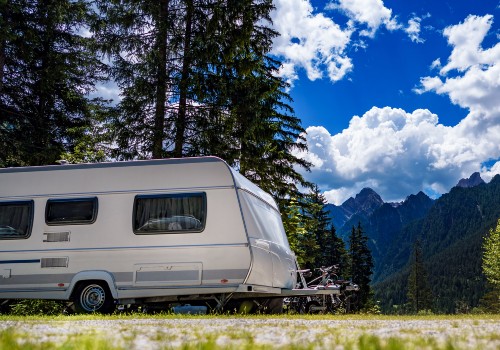
Lightweight travel trailers that use the designation “Lite” have fuzzy logic. Some can fall within the ultra-lite category while others lean more into the mid-size area. RV manufacturers created this term as a sales technique. The blogscape has worked hard to nail down a clearer picture.
We define this subcategory as travel trailers under 5,000 pounds and measure below 25 feet. There are enough models that fall within this criteria that aren’t ultra-lites to give them this classification. Many of their features are similar to ultra-lites, but these models give you more living space and have some upgraded features.
The kitchen will have more counter space to work. Master beds will have nightstands. Many of these models will be travel trailers with outdoor kitchens if you want to make the most of your tailgating experience (or keep the smell out of the coach on fish night).
The weight factor that we’re discussing concern the dry weight (also known as the Unloaded Vehicle Weight or Shipping Weight). The dry weight is the empty weight of the RV. Another weight factor we’ll discuss later is the Gross Vehicle Weight Rating (GVWR). This is the total weight the coach can safely hold when loaded with gear, filled water tanks, etc.
See our discussion on RV Weight Factors to learn more about this essential topic. Driving or towing, you need to know your weight numbers to avoid damaging your vehicle, avoid legal issues on the road, and other problems.
Mid-Size Travel Trailers (Under 8,000 Pounds, Below 30 Feet)
Mid-size travel trailers have been around for decades. In this category, the balance between space-saving versus comfort-level will lean toward fuller-sized features.
The weight of these RVs requires full-size SUVs and pickup trucks. The Ford Expedition or the Chevrolet Silverado 1500 will match well with this level of travel trailer.
You’ll see bunkhouse travel trailer floor plans with designated sections for the kids at one end and master suites on the other end. The diversity of interior floor plans will open up at this level, so it won’t be hard to find the perfect model.
Full-Length Travel Trailers (Up To 14,000 Pounds, Between 30-40 Feet)
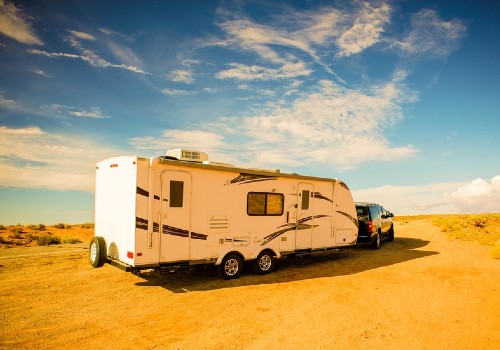
Full-length travel trailers are going to have the best quality features and amenities in the industry. Many of the 40-foot and longer versions share floor plans with fifth wheels. They’ll have large living room areas, full kitchens with islands, and king-size beds in the bedroom.
Those that want to use a travel trailer for full-time living will gravitate towards this sub-category. To pull these affordable palaces, you’ll need super/heavy-duty pickup trucks in the 250/2500 or 350/3500 series.
Kitchens will have residential amenities, living rooms, and bedrooms with pieces from the RV world’s best furniture collections. Those that work on the road will have a place to find their space to be productive (that is, if you can keep your eyes on your work instead of the picturesque scene outside your window).
Fish Houses
Fishing and RVing go hand-in-hand. For those polar warriors that go out on the ice to catch the big one when the temperatures are beyond reason, the RV industry has developed a mobile ice fish shanty to make your experience better.
Companies like Glacier, Ice Castle, and Yetti have travel trailers you can drive directly on the ice. They lower down to create a seal and have closeable floor holes that you can drill directly into the ice.
While you’re enjoying your time on the ice, these heavily insulated travel trailers offer TV prep walls, climate control, kitchenettes, and convertible furniture to spend the night. They range in size from the ultra-lite to mid-size weights.
Before you hitch up, make sure the lake allows your fish house travel trailer, and you have your fishing licenses—Check-in with the fish and game website or office in your area.
Fiberglass Shell
In the 1970s, a few years before the gas crisis, a company named Bolar created a new style of travel trailer. Instead of using a wood or aluminum frame like most RVs, they made a double-shelled fiberglass travel trailer. The shells give the RV its structural integrity and body. The trailer chassis is bolted to the molded shells, completing the RV.
In a failed attempt to expand, Bolar sold their dyes to other companies. Today, they’re known as Scamp and Casita. Oliver is another fiberglass company. You won’t find any of these travel trailers at an RV show or your local dealership since they only sell through direct order.
How do these companies compete when they only sell by word-of-mouth? If you put your order in today, you can expect your unit to be ready within six months to a year due to the backlog (and that’s before that pandemic). Each travel trailer is tailored to the customer’s needs and wants.
Toy Hauler Travel Trailers
We’ll discuss toy haulers in our feature article on them, but travel trailers are the second common category they’re found in (fifth wheels are the most popular). Companies like KZ have toy hauler travel trailers that fit in the Lite weight limits. You’ll find others that go all the way up to the full-size subcategory.
Travel Trailer Specification Ranges
| Lengths | 10-45 feet |
| Sleep | 2-12 people |
| Dry Weight (empty weight of the RV) | 600-12,000 pounds |
| Gross Vehicle Weight Rating (a.k.a. GVWR- the most weight the RV can safely hold) | 800-14,000 pounds |
| Price | $10,000- $175,000 |
Ideal Tow Vehicles
When you’re matching your tow vehicle to your travel trailer, you want to base it on the GVWR, not the dry weight. The best SUV for towing your travel trailer has to have the torque and horsepower to tow several things. It has to tow the weight of the RV, the weight of the water tanks, your stored gear, and the weight of everyone going on the trip.
The vehicle also has to handle its weight and tackle road conditions. Some use a set number like 1,000- 2,000 pounds above the dry weight; others use a percentage like 20% of the RV’s weight.
Here are some of the most popular SUVs and best trucks for towing a travel trailer:
| MODEL | TOW CAPACITY |
| Nissan Rogue | 1,102 lbs |
| Subaru Outback | 3,500 lbs |
| Chrysler Pacifica | 3,600 lbs |
| Audi Q5 | 4,400 lbs |
| Toyota Highlander | 5,000 lbs |
| Chevrolet Suburban | 6,300 lbs |
| Jeep Grand Cherokee | 7,200 lbs |
| Mercedes-Benz GLE | 7,700 lbs |
| Ford Expedition | 9,300 lbs |
Popular RV Manufactures of Travel Trailer
The great thing about the RV industry is the fact that every time someone in the blog-verse tries to create a complete list of all RV manufacturers, another one hangs their shingle.
The “Big Four” (Thor Industries, Forest River Incorporated, Winnebago Industries, and REV Group) may dominate the RV market, but the independents are keeping them on their toes with their innovations.
Here’s a list of popular RV manufacturers and those that need more recognition. You’ll find that these companies are the best travel trailer brands in today’s RV market.
| BRAND | MANUFACTURER |
| Airstream | Thor Ind. |
| Casita | Independent |
| Coachmen | Forest River Inc. |
| Coleman | Thor Ind. |
| CrossRoads | Independent |
| Dutchmen | Thor Ind. |
| Forest River | Forest River Inc. |
| Grand Design | Winnebago Ind. |
| Gulf Stream | Independent |
| Happier Camper | Independent |
| Highland Ridge | Thor Ind. |
| Ice Castle Fish House | Independent |
| Jayco | Thor Ind. |
| Keystone | Thor Ind. |
| KZ-RV | Thor Ind. |
| Lance | REV Group |
| Northwood RV | Independent |
| Oliver | Independent |
| Outdoors RV | Independent |
| nuCamp | Independent |
| Prolite | Independent |
| Scamp | Independent |
| Starcraft | Thor Ind. |
| Travel Lite | Independent |
| Winnebago | Winnebago Ind. |
| Yetti Outdoors | Independent |
Travel Trailer Standard Features Expectations
Kitchen
The kitchen features in travel trailers will allow you to cook meals. Except for a select few, you’ll have a sink and water heater. Stovetops will either be gas burners connected to the propane tank or electric. Refrigerators will range from dorm-size to full residential models.
Living Room
Small travel trailers integrate the seating into multi-purpose space. Dinettes and sofas will fold out for sleeping. Larger versions will have separate living room areas with theater seating and plush couches. Expect the sofas to be convertible for guest sleeping regardless of size.
Bedroom
Want to Connect With a Community of Over 1,078 RV Enthusiasts?
Master beds may be permanent, space-saving murphy beds, or fold-outs. Bunk bed spaces will be permanent and mostly enclosed to keep kids from rolling off. RV manufacturers will sacrifice space in the master bedroom on lightweight models to maximize space in the common space area.
Bathroom
Small travel trailers, even expensive Airstreams, will save space with combined wet bath configurations where the shower, sink, and commode are in the same space. Dry bathrooms either split the shower from the water closet by the center aisle or have an all-in-one bathroom. Full-size travel trailers with two bathrooms are available.
Storage Tanks
Some ultra-lite travel trailers will have a fresh and grey tank only. If you want a commode, you may have to purchase a portable cassette toilet five-gallon tank. Lite models and bigger will have fresh, grey, and black tanks as standard features.
Storage
Bigger travel trailers are going to have more exterior storage, but most space will still be within the cabinetry and furniture. RV manufacturers are strategic with hiding space under beds, dinette benches, and other available areas.
Power and Propane
Only the biggest travel trailers come in 50 amp service. Most will have 30 amp electric. Many gas generators have outlets that fit a 30 amp shore power RV cord into it. 50 amp RVs need two generators and a bridge device to power them. If you’re using a generator, be mindful of how much wattage you’re using.
All travel trailers now come with solar panel prewiring and ports you can plug them into directly. You can attach solar panels to your travel trailer’s roof since they’re strong enough to walk on. Do your research and consult with experts if you’re going to invest in this technology to avoid any problems.
Your propane system will power your water heater, furnace, stove, and oven. The furnace and stoves have come along way, but they will drain your tanks within a couple of weeks. Make sure you keep a weather eye on your propane levels through your control panel.
Technology
Virtually all travel trailers now come with multimedia sound systems. If your particular model doesn’t come with a TV, there are reinforced wall spaces to attach a TV mount. LEDs give you utility and aesthetic lighting with the lowest wattage use possible.
More expensive models have digital control panel displays and mobile apps to remotely control your RV. Tongue and stabilizer jacks work at the touch of a button for many bigger travel trailers.
Climate Control
Furnaces are almost always the first to come as standard features. If air conditioners are optional, RV dealers usually order them from the manufacturer already pre-installed. Full-size travel trailers will come with one air conditioner standard where the second is optional.
Great Examples of Travel Trailer
| The Best Ultra-Lite Travel Trailer | Happier Camper HC1 |
| The Best Vintage Travel Trailer Manufacturer | Riverside RV |
| The Best Fiberglass Travel Trailer | Casita Heritage Standard |
| Best Bunkhouse Travel Trailer Under 30 Ft. | Heartland North Trail 24BHS |
| The Best Off-Road Travel Trailer | Opus Camper OP-15 |
| The Best 4 Season Travel Trailer | Outdoors RV Titanium Blackstone 250RDS |
| The Best Travel Trailer for Full-Time Living | Forest River Heritage Glen 283RK |
Matching to Your Camping Style

Positive Travel Trailer Reviews and Ratings
The diversity of travel trailers make them ideal for every demographic out there. They fit almost every financial level, family size, and lifestyle. Movie star Matthew McConaughey travels the country in his 28-foot 2004 Airstream International; he named “The Canoe.”
There’s a reason the Big Four has so many brands under their umbrellas. Many brands specialize in individual styles of camping. Some are great for those just starting their RV adventures; others are ideal for full-timers, off-road enthusiasts, and different consumer interests.
The average length limit of national parks is 27-30 feet for their campsites. Ultra-lite and lightweight travel trailers fit nicely in these campgrounds. Bigger travel trailers may find a space in the more popular national parks. State, county, and private campgrounds will be more accommodating and have a wider variety of campsite amenities.
Boondockers will like camping off the grid with their travel trailer. You’ll need to bring an alternative power source like a gas generator, solar generator, or solar panel system. For extended dry camping, you can use portable sewer tanks to drive out your dirty water safely. Multi-gallon jugs are perfect for refilling your freshwater.
Is A Travel Trailer Worth It?
Compared to the more expensive categories, travel trailers aren’t going to have the ultimate features. You won’t find tile flooring, adjustable beds, or mansion-level features. RV manufacturers save those features for other RV classes near the million-dollar range.
All RVs have to be maintained. You must winterize and keep up with the preventive maintenance to retain the integrity of your investment. Over 90% of all repair problems boil down to the owner not doing their due diligence. Much of which can be done over a weekend or two with less than $50 of cleaning products, silicone caulk, and other easy-to-find products.
The Next Step
The RV buying process should be as fun as the RV camping experience. Now that you have some perspective, we always recommend renting some travel trailers before you buy. Using peer-to-peer companies like Outdoorsy or RVshare is worth the expense.
These companies allow you to rent from real owners. You can try out different subcategories with different floorplans. Having this firsthand experience is worth more than anything you’ll research. The owners will walk you through the RV showing you how to work everything. Some even offer to set it up for you on location.
Once you’ve tried a few and know the best size and floorplan, you can continue on our RV Troop website to look through an unbiased walk-through of the latest travel trailers on the market. You won’t have any sales representatives pushing you towards any particular brands, and we’ll point out any areas of concern we, other experts, and consumers find.
Welcome to the RV Lifestyle!
"Man cannot discover new oceans unless he has the courage to lose sight of the shore."
-- Andre Gide

